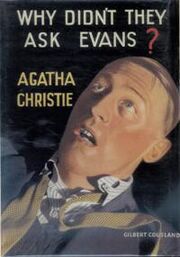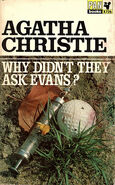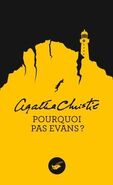
Dust-jacket illustration of the first UK edition
Why Didn't They Ask Evans? is a work of detective fiction by Agatha Christie which was first issued in abridged form in Redbook magazine in the US in Nov 1933. In book form it was first published in the United Kingdom by the Collins Crime Club in September 1934 and in the United States by Dodd, Mead and Company in 1935 around September[1] In the US publications, the title was The Boomerang Clue.
The UK edition retailed at seven shillings and sixpence (7/6) and the US edition at $2.00.
Plot summary[]
(may contain spoilers - click on expand to read)
Bobby Jones, the son of the vicar of the Welsh seaside town of Marchbolt, is playing a game of golf with a friend. He chips the ball over a cliff edge and when he goes to look for the ball he sees a man lying unconscious below. Bobby's companion goes for help while Bobby stays with the badly injured man. The man soon dies, but not before briefly regaining consciousness and saying “Why didn’t they ask Evans?” This and a photograph of a beautiful woman Bobby finds in the man's coat pocket are the only clues to his identity. While Bobby is waiting with the body another man finds him there. He introduces himself as Roger Bassington-ffrench and offers to stay with the body so Bobby will not be late to play the organ at his father's church.
The dead man is identified as Alex Pritchard by his sister, Amelia Cayman. She is said to be the woman in the photograph, and Bobby wonders how such a beautiful girl could become such a coarse older woman. After the inquest, Mrs. Cayman and her husband want to know if Pritchard had any last words. Bobby says that he did not. Later, when talking with his friend "Frankie" – Lady Frances Derwent – Bobby remembers that Pritchard did have last words and writes to the Caymans to tell them. He receives a polite but dismissive reply in the post.
Bobby is due to start work with a friend at his garage in London but receives an unexpected job offer from a firm in Buenos Aires. He rejects the offer. Soon afterward Bobby falls ill after drinking from a bottle of beer. The beer had been poisoned. The local police can only conclude the poisoning was the work of a madman, but Frankie thinks Bobby was targeted for murder. Bobby is convinced when he sees an old issue of the local paper that had printed the photograph used to find Pritchard's sister. Bobby immediately recognizes that the photo in the paper is not the one he found in the dead man's pocket. He and Frankie realize that Bassington-ffrench must have swapped the photograph while he was alone with the body and that Mrs. Cayman was likely not related to the dead man at all. Bobby and Frankie decide the best way to solve the mystery is to find Bassington-ffrench.
They manage to trace him to a house called Merroway Court in Hampshire, owned by his brother Henry and Henry's wife Sylvia. They stage a car accident outside the house with the help of a doctor friend so that Frankie (really uninjured) will be invited to stay at Merroway Court to "recover". Frankie produces a newspaper cutting about the mysterious dead man and Sylvia remarks that he looks like a man she'd met named Alan Carstairs. He was a traveler and big-game hunter who was a friend of John Savage, a millionaire who had killed himself a short time ago after finding out he had terminal cancer. Frankie is also introduced to two neighbors of the Bassington-ffrench’s – Dr. Nicholson and his younger wife, Moira. Dr. Nicholson runs a local sanatorium and Frankie writes to Bobby and gets him to investigate the establishment. He breaks into the grounds at night and comes across a young girl who says that she is in fear of her life – it is the same girl in the original photograph that Bobby found in the dead man’s pocket. Bobby has to leave the grounds before they are discovered.
Several days later, the girl turns up at the local inn where Bobby is staying. She identifies herself to him as Moira Nicholson. She is convinced that her husband is trying to kill her and she admits to knowing Alan Carstairs before her marriage to the doctor. Bobby introduces her to Frankie and it is Moira who suggests that they simply ask Roger if it was he who took the photograph on the body of the dead man. At the next opportunity, Frankie does so and Roger admits that did indeed take the picture, recognizing Moira and wanting to avoid a scandal for a family friend at the inquest, but he did not put in the photograph of Mrs. Cayman.
Interested in the will of the late John Savage, Frankie consults her own family solicitor in London and finds out that by coincidence Carstairs consulted him too. Savage was staying with a Mr. and Mrs. Templeton when he became convinced he had cancer, although one specialist told him it wasn’t the case and he was perfectly well. When he died by suicide, his will left seven hundred thousand pounds to the Templetons who have now gone abroad. Carstairs was also on their trail, suspicious of the will.
Bobby is kidnapped and Frankie is lured to his place of confinement – an isolated cottage and finds herself held as well. Their kidnapper is Roger but they manage to turn the tables on him and find Moira in the house but drugged. By the time the police arrive, Roger has escaped.
Bobby and Frankie trace the witnesses to the signing of John Savage’s will. They are the former cook and gardener of Mr. and Mrs. Templeton, Mr. Templeton being, in reality, Mr. Cayman. They are told that Gladys, the parlor maid, wasn’t asked to witness the will – made the night before Savage died - and realise that it must have been because she had previously served Savage during his stay (the cook and gardener hadn’t) and she would have realized that it was Roger who was taking his place in the "death-bed" after he forged the will's contents. They also discover that Gladys’ name was Evans, hence the reason for Carstairs’ question – "Why didn't they ask Evans?"
Tracing the parlor maid they are amazed to find that she is now the housekeeper at the vicarage of Bobby’s father. This is the reason for Carstairs visit to Wales – his attempt to find Evans when he grew suspicious of Savage's will and it is also the reason for the first attempt on Bobby’s life – the villains couldn’t risk Bobby (who found Carstairs’ body) being in the same house as Evans. Going back to Wales they find Moira who claims she is being followed by Roger and has come to them for help. Frankie though is not taken in and spoils Moira’s attempt to poison their coffee in the quiet country café they are in. Moira was Mrs. Templeton and Roger’s co-conspirator. Attempting to shoot Frankie and Bobby in the café when she is exposed, she is successfully overpowered.
Several weeks later, Frankie receives a letter from Roger, posted from South America, in which he confesses his part and Moira's part. Bobby and Frankie realize they are in love with each other and become engaged.
Characters in "Why Didn't They Ask Evans"[]
Marchbolt
- Robert "Bobby" Jones – son of the Vicar of Marchbolt
- Dr Thomas – a golfing partner of Bobby
- The Vicar of Marchbolt – Bobby's father
- Gladys Roberts, housekeeper at the vicarage, and her husband Roberts
- Alex Pritchard – Bobby finds him dying near Marchbolt after falling down a cliff
- Lady Frances "Frankie" Derwent – daughter of Lord Marchington
- Inspector Williams - a police officer in Marchbolt
- Mr Owen
- Frank
Merroway Court, Staverley and environs
- Henry and Sylvia Bassington-ffrench of Merroway Court in Hampshire
- Thomas Bassington-ffrench – their small boy
- Roger Bassington-ffrench – Henry's brother
- Dr Nicholson – runs sanatorium near Merroway Court
- Moira Nicholson – his wife
- Donald King - a pilot at Medeshot Aerodrome
- Thomas Askew - landlord of Anglers' Arms
- Reeves
London
- Colonel Rivington and his wife Edith
- “Badger” Beadon – Bobby's friend and owner of a garage in London
- George Arbuthnot – a doctor friend of Frankie's
- Mr Spragge
- Mr Elford
- Dolly Maltravers
- Messrs Gordon & Porter
Chipping Somerton
- Mr Leo and Mrs Amelia Cayman supposed brother-in-law and sister of Alex Pritchard
- Rose Pratt, née Chudleigh – former cook to "Mr and Mrs Templeton" and witness to John Savage's last will
- Albert Mere – former gardener to "Mr and Mrs Templeton" and witness to John Savage's last will
Others
- John Savage – recently deceased millionaire (mentioned)
- Angela (mentioned)
References to actual history, geography, and current science[]
As stated in the first chapter of the book, the name of the novel's hero - Bobby Jones - is a humorous allusion to the famous American golfer of the same name, who was at the height of his fame at the time of publication. Their successes at the game, though, are radically different from each other.
References to other works[]
- While at St Asaph's, Bobby likens Frankie to R. Austin Freeman's character Dr Thorndyke.
- At the nursing home Bobby starts to read a copy of the novel John Halifax, Gentleman, by Dinah Craik. He is more used to other kinds of books.
- When walking through a shrubbery at the Grange, Bobby Jones comes to think about Through the Looking-Glass by Lewis Carroll.
Literary significance and reception[]
The Times Literary Supplement of September 27, 1934, concluded favorably, "Mrs Christie describes the risks (Bobby Jones and Frankie Derwent) ran in her lightest and most sympathetic manner, playing with her characters as a kitten will play with a ball of wool, and imposing no greater strain on her readers than the pleasure of reading at a sitting a story that tickles and tantalises but never exhausts their patience or ingenuity".
Isaac Anderson in The New York Times Book Review of September 18, 1935 concluded, "Frankie and Bobby are not nearly so brilliant as amateur detectives usually are in books, but you are sure to like them, and you may even be able to forgive Agatha Christie for leaving out Hercule Poirot just this once."
The Observer of September 16, 1934, started off by saying that, "there is an engaging zest about Agatha Christie's latest novel" and concluded that "the narrative is lively" and "the story is full of action."
Milward Kennedy in his review in The Guardian of September 21, 1934 said after summarising the set-up of the plot that, "Poirot has no part in this book; instead, a young man and a young woman who blend charm and irresponsibility with shrewdness and good luck contrive amusingly and successfully to usurp the functions of the police. The fault which I find is the overimportance of luck. For the villains it was, for example, singular good luck which enabled them to discover and identify an obscure vicar’s fourth son asleep on a solitary picnic; it was very bad luck for them that he was able to assimilate a sixteenth times fatal dose of morphia. They were lucky, again, in having always at hand just the properties required to make an extempore murder seem something else; and as for the Bright Young Couple – but these are defects which are little noticeable in the gay stream of Mrs. Christie’s narrative. Perhaps I should not have noticed them had I not read the book so quickly that, in a secluded village, there was nothing for it next day but to read it again with a sterner eye but no less enjoyment."
Robert Barnard: "Lively, with occasional glimpses of a Vile Bodies world, though one short on Waugh's anarchic humor and long on snobbery ('Nobody looks at a chauffeur the way they look at a person'). Weakened by lack of proper detective: the investigating pair are bumbling amateurs, with more than a touch of Tommy and Tuppence"
References in other works[]
A character in the short story Problem at Sea, which appears in The Regatta Mystery and Other Stories and Poirot's Early Cases, mentions Bassington-ffrench (evidently Sylvia or Tommy, since Roger has fled and Henry is dead). In the same sentence, he also mentions someone named Badger, but that Badger's last name is Cotterill, not Beadon.
Adaptations[]
Why Didn't They Ask Evans (LWT, 1980)[]
Why Didn't They Ask Evans? was adapted by London Weekend Television and transmitted on Sunday, March 30, 1980.
Agatha Christie's Marple[]
In 2008 ITV made a TV film adaptation as part of their Agatha Christie's Marple series. This featured starring Julia McKenzie as Miss Marple, who does not appear in the original novel. The plot was largely rewritten by Patrick Barlow for this new version, which was first transmitted on Wednesday, June 15, 2009, on ITV.
Les Petits Meurtes d'Agatha Christie[]
A French adaptation Pourquoi pas Martin? was made as episode 4 of season 2 of the series Les Petits Meurtres d'Agatha Christie, first broadcast on France 2 on 27 Dec 2013.
Why Didn't They Ask Evans (Britbox, 2022)[]
A television adaptation directed by and starring Hugh Laurie, with co-starring Will Poulter and Lucy Boynton is scheduled to be released on Britbox in April 2022, with a later release on ITV.
Book dedication[]
The dedication of the book reads:
"To Christopher Mallock
in memory of Hinds"
The Mallock family were friends of Christie's from the years before her first marriage. They staged amateur theatricals at their house, Cockington Court, near Torquay in which Christie, managing to overcome her usual crippling shyness, took part. The allusion to Hinds is unknown.
Dustjacket blurb[]
The blurb on the inside flap of the dust jacket of the first UK edition (which is also repeated opposite the title page) reads:
"Believe it or not, Bobby Jones had topped his drive! He was badly bunkered. There were no eager crowds to groan with dismay. That is easily explained – for Bobby was merely the fourth son of the Vicar of Marchbolt, a small golfing resort on the Welsh coast. And Bobby, in spite of his name, was not much of a golfer. Still, that game was destined to be a memorable one. On going to play his ball, Bobby suddenly came upon the body of a man. He bent over him. The man was not yet dead. “Why didn’t they ask Evans?” he said, and then the eyelids dropped, the jaw fell...
It was the beginning of a most baffling mystery. That strange question of the dying man is the recurring theme of Agatha Christie’s magnificent story. Read it and enjoy it."
Publication history[]
- 1933: Redbook magazine, vol. 62 no. 1, November 1933. Abridged, as "The Boomerang Clue".[2]
- 1934: Six Redbook Novels, The McCall Company (abridged version).[3]
- 1934: Collins Crime Club (London), September 1934, Hardcover, 256 pp (priced at 7/6 - seven shillings and sixpence)
- 1935: Dodd Mead and Company (New York), 1935, Hardcover, 290 pp as The Boomerang Clue (priced at $2.00).
- 1935: Albatross Crime Club (Leipzig etc), pbk, 1935
- 1944: Dell Books (New York), Paperback, (Dell number 46 map back), 224 pp
- 1956: Fontana Books (Imprint of HarperCollins), Paperback, 192 pp
- 1968: Greenway edition of collected works (William Collins), Hardcover, 288 pp
- 1968: Greenway edition of collected works (Dodd Mead and Company), Hardcover, 288 pp
- 1974: Ulverscroft Large-print Edition, Hardcover, 394 pp ISBN 0-85456-270-2
- 1978: Pan Books, Paperback, ISBN 0-330-10736-4
- 1969: Agatha Christie Crime Collection (omnibus), Paul Hamlyn, 1969.
- 1985: Five Classic Murder Mysteries (omnibus), Avenel Books, 1985.
- 2006: Agatha Christie 1930s Omnibus, HarperCollins, 2006.
International titles[]
- Bulgarian: Защо не повикаха Евънс? (Why Didn't They Call For Evans?)
- Czech: Proč nepožádali Evanse? (Why Didn't They Ask Evans?)
- French: Pourquoi pas Evans ? (Why not Evans?)
- German: Ein Schritt ins Leere (A Step Into the Nothing)
- Hungarian: Miért nem szóltak Evansnek? (Why Didn't They Ask Evans?)
- Italian: Ritratto di ignota (Portrait of unknown), secondarily Perchè non l'hanno chiesto ad Evans? (Why Didn't They Ask Evans?)
- Slovak: Prečo nepožiadali Evans? (Why Didn't They Ask Evans?)
- Swedish: Varför bad de inte Evans? (Why Didn't They Ask Evans?)
Worldwide Covers[]
References[]
- ↑ US newspaper reviews of the book start appearing in late Sep 1934.
- ↑ See this listing at Galactic Central
- ↑ The other five condensed novels in this volume were The Thin Man by Dashiell Hammett, The Figure in the Fog by Mignon G. Eberhart, The Cross of Peace by Philip Gibbs, White Piracy by James Warner Bellah and Parade Ground by Charles L. Clifford.






